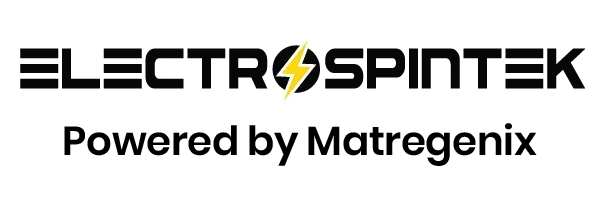Electrospinning has rapidly become one of the most exciting fabrication methods for creating nanofibers with extraordinary properties. At Electrospintek, we’ve seen how subtle tweaks in electrospinning parameters can dramatically change the quality of fibers. Among these parameters, electrospinning voltage plays a pivotal role in determining the morphology, diameter, and overall performance of the produced nanofibers.
In this article, we’ll explore how voltage influences fiber quality, why it matters, and how researchers and industries alike can achieve better control over the process.
Understanding Electrospinning Voltage
When we talk about electrospinning voltage, we’re referring to the high voltage applied between the polymer solution and the collector. This electric field initiates and sustains the spinning jet that stretches the polymer into ultrafine fibers.
Think of voltage as the “engine” that drives the process. Too low, and the jet may not even form. Too high, and the process becomes unstable, leading to defects like beads, irregular thickness, or even fiber breakage. Finding the sweet spot is essential for maintaining jet stability in electrospinning and achieving consistent, high-quality fibers.
Voltage and Fiber Morphology Control
Fiber morphology the shape and structure of fibers depends strongly on the voltage applied. At lower voltages, the polymer jet lacks sufficient stretching force, often producing fibers with larger diameters or inconsistent structures. On the other hand, when the voltage is increased, the electric field enhances stretching, which can refine the fibers, making them thinner and smoother.
However, there’s a caveat. Excessively high electrospinning voltage may destabilize the jet, creating beads, branching, or uneven surfaces. This is why fiber morphology control requires not just adjusting voltage, but also balancing it with other electrospinning parameters like flow rate, tip-to-collector distance, and polymer concentration.
Influence on Nanofiber Diameter
One of the clearest outcomes of voltage variation is its effect on nanofiber diameter. Generally, higher voltages produce thinner fibers because of increased stretching forces. For applications like filtration, wound healing, or energy storage, controlling fiber diameter is crucial. Smaller diameters mean larger surface area-to-volume ratios, which often translates to better performance.
Yet, diameter reduction isn’t always linear. Beyond a certain threshold, further increases in electrospinning voltage can cause chaotic jet behavior. Instead of uniform thin fibers, you might end up with uneven thickness, merged fibers, or even broken strands. At Electrospintek, we emphasize optimizing voltage in tandem with other process conditions to keep fiber diameters within target ranges.
The Role of Polymer Solution Conductivity
While voltage is critical, it doesn’t act in isolation. The polymer solution conductivity significantly interacts with applied voltage to influence outcomes. A highly conductive solution responds more strongly to the electric field, making it easier to stretch and form thinner fibers at lower voltages. Conversely, low conductivity may require higher voltages to initiate and maintain a stable jet.
This interplay highlights why a “one-size-fits-all” approach doesn’t work in electrospinning. Adjusting voltage without considering the solution’s properties often leads to poor results. By carefully tuning both, manufacturers can achieve precise fiber morphology control while maintaining process efficiency.
Jet Stability in Electrospinning
Perhaps the most challenging aspect of voltage adjustment is maintaining jet stability in electrospinning. A stable jet ensures smooth, continuous fiber production. When voltage is too low, the jet may sputter or fail to form. Too high, and the jet whips uncontrollably, producing defects or irregular deposition patterns.
Stable operation usually falls within a narrow voltage window, which varies depending on the polymer type, solvent system, and environmental factors like humidity. At Electrospintek, our engineers focus on fine-tuning this window to maximize production consistency while minimizing defects.
Practical Insights for Voltage Optimization
For researchers and industries aiming to optimize electrospinning voltage, here are a few practical insights:
- Start with moderate voltage settings and gradually adjust upward until the jet forms reliably.
- Observe fiber morphology carefully smooth, bead-free fibers often indicate the right voltage balance.
- Adjust other parameters in parallel, including flow rate and solution concentration, since they directly influence how voltage affects the jet.
- Use solution conductivity as a guide, especially when working with new polymer systems.
- Monitor environmental conditions, since humidity and temperature can subtly shift the ideal voltage range.
Why Voltage Matters for Applications
Different applications demand different fiber qualities. For instance:
- Medical textiles often require ultra-thin, uniform fibers to promote cell growth.
- Filtration systems rely on controlled diameters to trap fine particles.
- Energy devices like batteries and supercapacitors benefit from precise nanofiber diameter control to maximize surface area.
In all these cases, electrospinning voltage directly influences whether fibers meet performance expectations or fall short.
Conclusion:
In the world of electrospinning, voltage isn’t just a number it’s the heart of the process. It dictates whether fibers are smooth or bumpy, thick or thin, stable or chaotic. While it works in concert with other electrospinning parameters, voltage remains the lever that gives manufacturers the greatest influence over fiber quality.
At Electrospintek, we believe that mastering electrospinning voltage is the foundation for creating advanced materials that serve industries ranging from healthcare to energy. With careful tuning and scientific precision, it’s possible to achieve fibers that not only look good under the microscope but also perform flawlessly in real-world applications.
